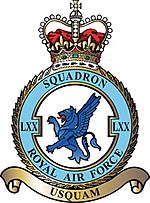No. 70 Squadron RAF
| No. 70 Squadron RAF | |
|---|---|
 |
|
| Active | 22 Apr 1916–2 Jan 1920 1 Feb 1920–31 Mar 1946 15 Apr 1946 – 1 Apr 1947 1 May 1948 – 8 Sep 2010 1 Oct 2014 – |
| Role | Air Transport |
| Garrison/HQ | RAF Brize Norton |
| Motto(s) | Latin: Usquam("Anywhwere") |
| Equipment | Airbus A400M Atlas |
| Battle honours | Western Front 1916–1918*, Somme 1916*, Arras, Ypres 1917*, Somme 1918, Kurdistan 1922–1924, Iraq 1918–1929, Kurdistan 1930–1931, Northern Kurdistan 1932, North West Frontier 1937, Mediterranean 1940–1943, Egypt and Libya 1940–1943*, Greece 1940–1941, Syria 1941, Iraq 1941*, El Alamein, North Africa 1942–1943*, El Hamma, Sicily 1943, Italy 1943–1945*, Salerno, Anzio and Nettuno, Gustav Line, Gothic Line, South East Europe 1944–1945*, South Atlantic 1982, Gulf 1991.Honours marked with an asterisk are those emblazoned on the Squadron Standard |
| Insignia | |
| Squadron badge heraldry | A demi-wing lion erased. Developed from an unofficial winged lion badge probably derived from the Squadron's long dependence on the Napier Lion engine during the 1920s. |
No. 70 Squadron (also known as No. LXX Squadron) of the Royal Air Force is the first operational unit to use the new Airbus A400M Atlas.
The squadron was formed on 22 April 1916 at Farnborough, and was equipped with the Sopwith 1½ Strutter. The squadron was posted to France, and in 1917 re-equipped with Sopwith Camels.
During World War I, the squadron claimed 287 victories, and had as members nineteen aces, including Frank Granger Quigley, John Todd, Frank Hobson, Oscar Heron, Frank Gorringe, Walter M. Carlaw, George Robert Howsam, Clive Franklyn Collett, Alfred Michael Koch, Kenneth Bowman Watson, Noel Webb, Edward Gribben, and Frederic Laurence.
The squadron briefly disbanded in January 1920, reforming nine days later at Heliopolis, Egypt, via the renumbering of No. 58 Squadron. The squadron was now a bomber-transport unit operating the Vickers Vimy bomber. After transferring to Hinaidi, Iraq in December 1921, the squadron was re-equipped with Vickers Vernon’s and subsequently by Vickers Victoria in 1926. In addition to providing heavy transport facilities to both air and ground units they were used as air ambulances and were responsible for maintaining the Cairo-Baghdad airmail route. The squadron was commanded by Group Captain Eric Murray DSO MC. In 1929, he flew the first route to the Cape on behalf of Imperial Airways who were seeking routes for the civil flights.
...
Wikipedia
